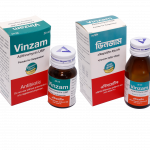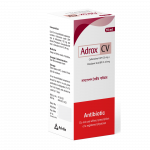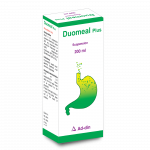Composition
Ciproxen Powder for Suspension: Each 5 ml reconstituted suspension contains Ciprofloxacin Hydrochloride USP 291.10 mg equivalent to Ciprofloxacin 250 mg.
Pharmacology
Ciprofloxacin is a synthetic quinolone anti-infective agent. Ciprofloxacin has broad spectrum of activity. It is active against most Gram-negative aerobic bacteria including Enterobacteriaceae and Pseudomonas aeruginosa. Ciprofloxacin is also active against Gram positive aerobic bacteria including penicillinase producing, non-penicillinase producing, and methicillin resistant staphylococci, although many strains of streptococci are relatively resistant to the drug. The bactericidal action of Ciprofloxacin results from interference with the enzyme DNA gyrase needed for the synthesis of bacterial DNA. Following oral administration, it is rapidly and well absorbed from the Gastro Intestinal tract. It is widely distributed in the body tissues and fluids. The half-life is about 3.5 hours. About 30% to 50% of an oral dose of Ciprofloxacin is excreted in the urine within 24 hours as an unchanged drug and biologically active metabolites.
Indications
Urinary tract infections, respiratory tract infections, gastrointestinal tract infections, uro-genital tract infections, bone and joint infections, skin and skin structure infections, and systemic infections.
Dosage & Administration
Adolescents and children: As with other drugs in its class, Ciprofloxacin has been shown to cause arthropathy in weight-bearing joints of immature animals. Although the relevance of this to man is unknown, its use in children, growing children and adolescents is not recommended. However, where the benefit of using Ciprofloxacin is considered to outweigh the potential risk, the dosage should be 7.5-15 mg/kg/day depending upon the severity of infection, administered in two divided doses.
Adult:
Urinary tract infections: 250–750 mg 12 hourly for 3 to 14 days.
Acute Sinusitis: 500 mg 12 hourly for 10 days.
Bone and Joint infections: 500-750 mg 12 hourly for 4 to 6 Weeks.
Skin and skin structure infections: 500-750 mg 12 hourly for 7 to 14 days.
Infectious Diarrhoea: 500 mg 1 hourly for 5 to 7 days.
Typhoid Fever: 500 mg 12 hourly for 10 days.
Gonorrhoea: 250-500 mg as a single dose.
Lower respiratory-tract infections: 400 mg 8-12 hourly for 7 to 14 days.
Most other infections: 500 mg twice daily increased to 750 mg 12 hourly in severe or deep-seated infection.
Reconstitution Procedure
First, shake the bottle to loosen the powder, then add 10 teaspoons or 50 ml (using the provided measuring cup) of freshly boiled water to cool the bottle and shake well to prepare a 60 ml suspension. The suspension should be used within 7 days of preparation and prepared suspension 30⁰C. must be stored below temperature.
Contraindication
Ciprofloxacin is contraindicated in case of known hypersensitivity to it, quinolone antibiotics, or any other components of this product.
Warning & Precaution
It should be used with caution in patients with suspected or known CNS disorders such as arteriosclerosis or epilepsy or other factors which predispose to seizures and convulsion.
Side Effects
Ciprofloxacin is generally well tolerated. The most frequently reported adverse reactions are nausea, abdominal pain, and dyspepsia, diarrhea, vomiting and rash.
Use in Pregnancy & Lactation
Reproduction studies performed in mice, rats and rabbits using parenteral and oral administration did not reveal any evidence of teratogenicity, impairment of fertility or impairment of peri/postnatal development. However as with other quinolones, Ciprofloxacin has been shown to cause arthropathy in immature animals and therefore its use during pregnancy is not recommended. Studies in rats have indicated that Ciprofloxacin is secreted in milk, administration to nursing mothers is thus not recommended.
Drug Interaction
Concurrent administration of Ciprofloxacin should be avoided with Magnesium or Aluminum containing antacids or sucralfate or with other products containing Calcium, Iron or Zinc. These products may be taken two hours after or six hours before Ciprofloxacin. Ciprofloxacin should not be taken concurrently with milk or other dairy products, since absorption of Ciprofloxacin may be significantly reduced. Dietary calcium is a part of a meal, however, does not significantly affect the absorption of Ciprofloxacin.
Overdose
In the event of acute overdose, reversible renal toxicity has been reported in some cases. The stomach should be emptied by inducing vomiting or by gastric lavage. Calcium or magnesium containing antacid may be administered as soon as possible after ingestion of ciprofloxacin in order to reduce the absorption of ciprofloxacin.
Storage
Store below 30°C, protect from light & moisture. Keep out of the reach of children.
Packing
Ciproxen Powder for Suspension: Each box contains an amber glass bottle containing dry powder to reconstitute 60 ml suspension with measuring cup and dropper.






